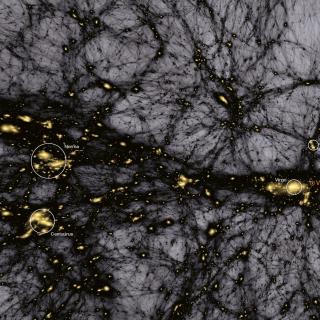Bibcode
Webber, K. B.; Hansen, T. T.; Marshall, J. L.; Simon, J. D.; Pace, A. B.; Mutlu-Pakdil, B.; Drlica-Wagner, A.; Martínez-Vázquez, C. E.; Aguena, M.; Allam, S. S.; Alves, O.; Bertin, E.; Brooks, D.; Carnero Rosell, A.; Carretero, J.; da Costa, L. N.; De Vicente, J.; Doel, P.; Ferrero, I.; Friedel, D.; Frieman, J.; García-Bellido, J.; Giannini, G.; Gruen, D.; Gruendl, R. A.; Hinton, S. R.; Hollowood, D. L.; Honscheid, K.; Kuehn, K.; Mena-Fernández, J.; Menanteau, F.; Miquel, R.; Ogando, R. L. C.; Pereira, M. E. S.; Pieres, A.; Plazas Malagón, A. A.; Sanchez, E.; Santiago, B.; Smith, J. Allyn; Smith, M.; Suchyta, E.; Tarle, G.; To, C.; Weaverdyck, N.; Yanny, B.
Referencia bibliográfica
The Astrophysical Journal
Fecha de publicación:
12
2023
Revista
Número de citas
7
Número de citas referidas
7
Descripción
We present a detailed chemical abundance analysis of the brightest star in the ultrafaint dwarf (UFD) galaxy candidate Cetus II from high-resolution Magellan/MIKE spectra. For this star, DES J011740.53-173053, abundances or upper limits of 18 elements from carbon to europium are derived. Its chemical abundances generally follow those of other UFD galaxy stars, with a slight enhancement of the α-elements (Mg, Si, and Ca) and low neutron-capture element (Sr, Ba, and Eu) abundances supporting the classification of Cetus II as a likely UFD. The star exhibits lower Sc, Ti, and V abundances than Milky Way (MW) halo stars with similar metallicity. This signature is consistent with yields from a supernova originating from a star with a mass of ~11.2 M ⊙. In addition, the star has a potassium abundance of [K/Fe] = 0.81, which is somewhat higher than the K abundances of MW halo stars with similar metallicity, a signature that is also present in a number of UFD galaxies. A comparison including globular clusters and stellar stream stars suggests that high K is a specific characteristic of some UFD galaxy stars and can thus be used to help classify objects as UFD galaxies. * This paper includes data gathered with the 6.5 m Magellan Telescopes located at Las Campanas Observatory, Chile.
Proyectos relacionados

Cosmología con Trazadores de la Estructura a Gran Escala del Universo
El Fondo Cósmico de Microondas (FCM) contiene la información estadística de las semillas primigenias que han dado lugar a la formación de todas las estructuras en el Universo. Su contrapartida natural en el Universo local es la distribución de las galaxias que surgen como resultado del crecimiento gravitatorio de aquellas fluctuaciones de densidad
FRANCISCO SHU
KITAURA JOYANES